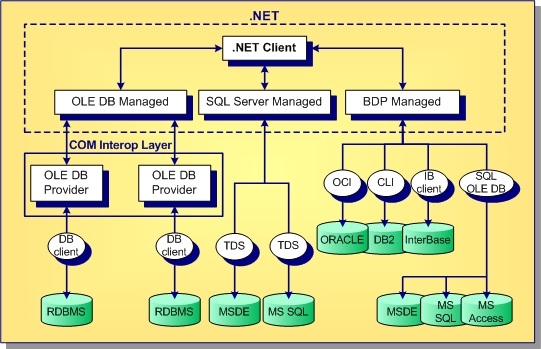|
RAD Studio for Microsoft .NET
|
|
RAD Studio for Microsoft .NET
|
In addition to supporting the providers included in the .NET Framework, RAD Studio includes AdoDbxClient Providers for Microsoft .NET.AdoDbx Client is an implementation of the .NET Provider and connects to a number of popular databases.
This topic includes:
RAD Studio supports the .NET Framework providers and the AdoDbx Client providers.

AdoDbx.NET provides a high performance architecture for accessing data sources without a COM Interop layer.
The architecture exposes a set of interfaces for third-party integration. You can implement these interfaces for your own database to provide designtime, tools, and runtime data access integration into the CodeGear IDE. AdoDbx.NET -managed components communicate with these interfaces to accomplish all basic data access functionality. These interfaces were implemented to wrap database-specific native client libraries by way of Platform Invoke (P/Invoke) services. Depending on the availability of managed database clients, you can implement a fully-managed provider underneath AdoDbx.NET.
The database-specific implementation is wrapped into an assembly and the full name of the assembly is passed to the AdoDbxConnection component as part of the connection string. Depending on the Assembly entry in the ConnectionString property, AdoDbx.NET dynamically loads the database-specific provider and consumes the implementation for ISQLConnection, ISQLCommand, and ISQLCursor. This allows you to switch applications from one database to another just by changing the ConnectionString property to point to a different provider.
AdoDbx.NET provides a number of advantages:
The DataSet is an in-memory representation of one or more DataTables. Each DataTable in a DataSet consists of DataColumns and DataRows. The DataSet is generated as a result of an SQL query that you supply to the provider. You can navigate the DataSet like you would any standard relational table. AdoDbx.NET providers encapsulate implementation details for each database type, yet allow you to customize your SQL statements and manage the result sets with complete flexibility.
AdoDbx.NET includes several designtime components that you can place onto a Windows Form or Web Form. A set of designers are also provided to help you build your data connections, DataSets, relations, and other elements.
The primary components that are most useful, particularly if you decide to implement your own database-specific provider, are:
AdoDbx.NET includes providers for a number of industry-standard databases. These are shown in the following table, along with their corresponding namespaces.
|
Database |
Namespace |
|
InterBase |
Borland.Data.Interbase |
|
Oracle |
Borland.Data.Oracle |
|
IBM DB2 |
Borland.Data.Db2 |
|
Microsoft SQL Server |
Borland.Data.Mssql |
|
Microsoft Access |
Borland.Data.Msacc |
|
Sybase |
Borland.Data.Sybase |
The AdoDbx.NET components, metadata access, and designers are defined under the following namespaces:
AdoDbx.NET maps SQL data types to .NET Framework data types, eliminating the need for you to learn a database-specific type system. Every attempt has been made to implement consistent type mappings across database types, allowing you to write one set of source that you can run against multiple databases. You can achieve a similar effect with the .NET Framework data providers by communicating with their interfaces directly and by using untyped ancestors. However, once you use strongly typed accessors, your application becomes less portable. AdoDbx.NET does not support any database-specific typed accessors. For more information, see the AdoDbx.NET Data Types topic.
You can extend AdoDbx.NET to support other DBMSs by implementing a subset of the .NET Provider interface. AdoDbx.NET generalizes much of the functionality required to implement data providers. While the .NET Framework gives you the capabilities to create individual data providers for each data source, CodeGear has simplified the task by offering a generalized set of capabilities. Instead of building separate providers, along with corresponding DataAdapters, DataReaders, Connection objects, and other required objects, you can implement a set of AdoDbx.NET interfaces to build your own data source plug-ins to the AdoDbx Client Provider.
Building plug-ins is a much easier task than building a completely new data provider. You build an assembly that contains the namespace for your provider, as well as classes that encapsulate provider-specific functionality. Much of the functionality you need to connect to, execute commands against, and retrieve data from your data source has already been defined in the AdoDbx Client Provider interfaces.
|
Copyright(C) 2008 CodeGear(TM). All Rights Reserved.
|
|
What do you think about this topic? Send feedback!
|